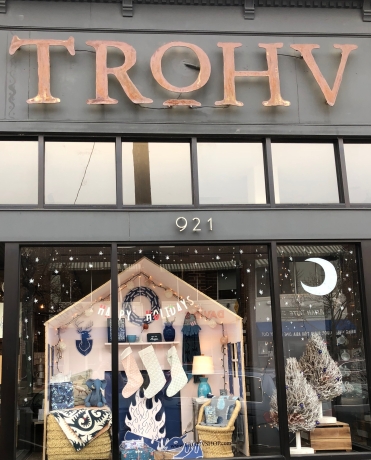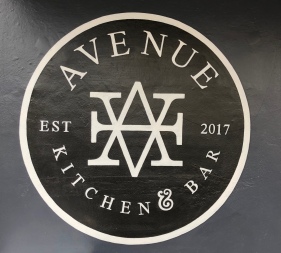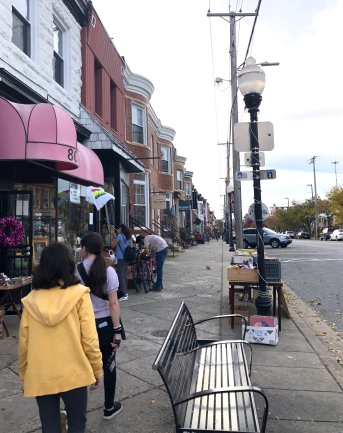By Maya Murphy
Walking down Main Street, you are transported to a different time, a different era. Small shops, with multicolored storefronts and awnings, sandwiched between historic red brick, line the two-lane street. Stone churches that have stayed true to faith or have since been converted to modern establishments are scattered throughout the street.
It is October in Maryland, and thankfully, it’s a beautiful day. The sun is peaking out of clouds, casting a warm ray down on Main Street. Leaves on the trees have just begun to change colors, some premature leaves have already fallen and are covering the harsh black asphalt and creating a road of yellow orange that decorates the small community of Hampden.
The mystery of Sugar lies behind frosted glass window panes and a massive pink flamingo, towers over Café Hon, watching over its home. Kiss N Makeup stands bold with its bubble gum pink exterior, peaking up from under Luigi’s Italian Deli, while the beautiful window displays in both Trohv and In Watermelon Sugar encourage any passersby to stop and take a look.
If you are lucky, Killer may grant you with a presence (or beg for a pet), a friendly local tabby cat who has adopted Main Street as its home. Everyone in Hampden knows Killer, and Killer knows when Nori, the local sushi shop, opens for the early dinner rush.
From unusual antiques to nostalgic keepsakes, the beautifully tacky and ultra-hip Hampden caters to everyone.

Hampden was named after English politician John Hampden, and originally settled as a mill town, with its residents having strong roots in the blue-collar district. The area grew rapidly due to the amount of jobs located in the vicinity. It was a primarily white, working class community and stayed hidden from the public’s eye for many years.
In the 1990s the area of Hampden was rediscovered mainly by college-aged students and artists. The young residents were attracted to the artist studio, the Mill Centre, located at the southernmost area of Hampden.
I was in shock at the pure scale of the building… it was huge to say the least, and although I did not wander inside, I could imagine the amount of pure creativity flowing through its walls.
The Mill Centre’s original use was for the creation of textiles, to manufacture fabrics later to be used for the sails on ships that came through Baltimore’s Inner Harbor. In 1987 the building was renovated from a factory to a more habitable building. The building is now considered home for over 80 tenants all practicing various artistic occupations, including photographers, graphic designers, architects, painters and writers. The Mill Centre is a community in itself, and offers a gym, yoga studios, eateries and massage therapists, as well as maintenance staff on call who are dedicated to preserve the old building.
More diverse Hampdenites are now migrating to the area, with an emphasis on younger generations. Hipsters and self-proclaimed artists are finding refuge in this unified town.

Drawn to the monster-sized flamingo sporting a beehive hair style classic to the 1960s, I decided to pop into Café Hon and see what the drama was all about.
Café Hon, a Baltimore icon, opened in 1992. The distinctive Baltimorean word “Hon” comes from the shortening of the word “Honey.” The term “Hon” began as an informal greeting mainly aimed at women in the 1950s-1970s. During this time, the women of various Baltimore districts wore brightly colored and patterned clothing. Most men wore general factory clothing, making the vibrant clad women stand out.
A rule that still remains in play regarding the term, is that it always goes at the end of the sentence, a waitress at Café Hon recalled.
The gentle touch of decorating the now Baltimore staple was tasked, and in 2002, the colossal flamingo was born.
A waitress, who has been working at Café Hon for years, said there were some issues in the following years regarding the flamingo.
In 2009 the city of Baltimore announced that Café Hon had to get a permit for the flamingo or they were forced to take it down. However, it was the flamingo that put Café Hon on the map, so the thought of taking it down was not an option. It hibernated for its time of absence and a new fiberglass version is back up today.
Entering the café was like stepping back in time – to your grandmother’s kitchen. The aroma of comfort food wafted through the small dining room. On the left a wooden bar painted green, stocked to the brim with various alcohols, somehow balanced the wooden shiplap walls adorned with photographs of different species of birds.
The tables were all different; black booths lined the far wall, and two wooden high tops with metal bar stools lined the other. A small red booth sat hidden in the corner, waiting for the right person to walk in who was adventurous enough to try a brilliant red booth instead of the black. A large family style sharing table took up most of the space in the center of the room, with a basket of imperfect and bruised apples sitting purposefully on top. Some tables were clothed with seasonal throws, while years of wear showed on the tops of others. Each one was unique, with its own personality shining through.
The warmth shone by both the carefully chosen lighting pieces and the staff radiated from inside, creating a homey atmosphere, where you could lose your stressors (for the time you had for a lunch break) and focus on friends, family and food.
“Have a great day, Hon!” The waitress called after me as I walked out the door.

On the way back to my car to check the meter, I was bestowed the pleasure of petting an orange tabby, who was avidly meowing at the emerald green door to Nori, the local sushi shop. The cat was not getting a snack anytime soon for it was still too early in the afternoon for them to be open, yet he just continued to paw the door. I threw a few more quarters into the meter, ready to continue when a man stepped out of Nori and asked if I knew Killer.
Assuming Killer was the cat, I told him no, and that I was not a Hampdenite and was just visiting.
He asked if I had been to Nori yet, having just opened this past summer, to which I again responded no.
The sushi and Korean restaurant opened in July only a few months after the previous tenant, the Corner Restaurant and Charcuterie Bar, had closed. Something Hampden’s Main Street did not have was sushi and where there was a need there was a dream.
Nori’s owner, in a Baltimore Sun interview, said how he wants to serve upscale sushi in a causal setting, perfect for Hampden. He also has the ability to create more interesting dishes, figuring the “up-and-coming millennials and hipsters” are more willing to try new things.
Kevin, the sushi roller at Nori, had said Main Street, in particular, is small business-oriented and supports entrepreneurs.
Hampden is not considered corporate and only a few chain restaurants are in the surrounding area. It’s a place where restaurateurs can build a business with their own two hands, and continue to make it better.
He talked about how a great representation of the Hampden culture is portrayed through the eateries in the area. There’s everything from American cuisine, like the Five N Dime, Café Hon and The Food Market, to true cultural cuisines like Nori, Daniela’s (Italian), Golden West Cafe (Southwestern American), The Verandah (Indian) and Souvlaki Greek Cuisine.

We made our way down Main Street just as the kids were coming home from school. Kids of all colors and all nationalities came bustling down the road, laughing with each other after a presumably long day of school. They looked as if they did not have one care in the world, their smiling faces beamed in the late afternoon glow.
Kevin explained it perfectly: that Hampden is a distinct destination spot, where everyone is extremely diverse.
Very diverse is correct, but being diverse does not mean everything is perfect. However, in Hampden, everyone seems to know each other and harmoniously gets along no matter how they look.
Will Bauer, better known as Lou Catelli, is the unofficial major of Hampden and is considering running for the official major of Baltimore in 2020. You could spot Catelli from a mile away in his signature top knot bun, tricycle and lack of long pants. According to an article from Baltimore Magazine, Catelli said, “We have to bring Baltimore the love it deserves and keep moving forward.”

When walking into what one would imagine was the orange entrance to the Yoga Tree, you arrive at a carpeted ramp going downstairs, further inside the building. To the left was an area of what looked like a takeout window from the previous restaurant. It was transformed into The Sidebar, where foodies can grab a small plate or cocktail and enjoy some people watching out the large café style window.
Co-owners Bill Irvin and Patrick Dahlgren opened the Avenue Kitchen and Bar in the summer of last year. The pair redid the space, with the goal to freshen it up.
They wanted to construct a more intimate environment that was both fun and upscale where anyone felt welcome by “creating great food, great drink and great atmosphere,” said Bill.
The menu includes classic Maryland dishes and new takes on old favorites. Bill, considered a wine connoisseur, keeps the bar stocked with a variety of unique wines imported from Europe.
The ramp lead to a warmly lit space that was divided in half, the left being more of a bar side and the right being the sit-down restaurant side. The restaurant gave off the vibe of an old speakeasy, a dimly lit, darkly painted room, with quiet jazz playing in the background; all it needed was the perfume of cigarette smoke. The accents, including shiplap plank on the far wall and plates, were a bright white thus slightly brightening up the space, giving it a crisp clean feel. The dark metal, juxtaposed with the warm lighting gave the restaurant a navy-blue hue and created an intimate atmosphere. The shelving unit had square cubbies with candles twinkling and sconce lighting on the sides. Each “room” could be rented out to fit a party’s needs.
Bill said when one goes to Hampden they find real chefs and find real food.
He talked to me about the daunting task of having a restaurant in Hampden. The high competition from Baltimore and even other cities is a huge impact on the non-commercialized food chain. He said how, “No one just wants to visit Baltimore.”
Which in a way is true. Baltimore is not home to many large corporations and lacks the business traffic of other bigger cities such as New York or Chicago. While the Inner Harbor and downtown Baltimore grab most of the tourists, victors don’t always gravitate to Northern Baltimore, despite its charming reputation and notable neighborhoods. It wasn’t called Charm City for no reason, you see.

According to a Baltimore Magazine article, Catelli says “We are the greatest city and the greatest town, the greatest neighborhood on the face of the Earth, ever. We want to bring the joy back.”
Bill says how some of the best restaurateurs are in Hampden and the surrounding areas, simply deemed the best because they had the dream of creating a world class restaurant and Hampden was what made it possible. They just do not get the recognition. That’s why he says, he is constantly coming up with new ideas to inspire people and to get them out of their house and experience something cool in an underground town not many know about.
Bill and Patrick created an outdoor eating experience this past summer in Hampden’s Rotunda dubbed the Garden Party, a seasonal pop-up shop and bar serving high class on the go meals including charcuterie boards, tiny sandwiches and salads. The pair also created the Tiny Wine Shop, a standalone kiosk selling a variety of fine wines imported from Europe and a selection of local beers and spirits. Bill also recently created Taco Noche, also located in the Rotunda featuring handcrafted tacos and margaritas. And he will not stop creating; if there’s an idea and a will, there is a way for him to make it come to life.
At this point it was my time to go, and I said au revoir to my new friends. I decided to do one more lap around Main Street before heading back to my car, wondering if Killer would still be there begging for a taste of sushi. The smell of waffle cone danced around my nose in passing The Charmery, an old-fashioned ice cream shop intriguing visitors with its interesting yet delectable flavors (Old Bay Caramel being a Baltimore favorite).
Leaves crunched under my feet, and a feeling of happiness washed over me. For a neighborhood not many know about, I felt welcomed and a member of their community within a matter of hours. Hampden gave off a cheerful disposition, and it’s hard to believe anyone could be angry in a place like this, where you only had to walk a few feet to find something truly amazing.
Each time I have returned to Hampden I have found something new, adding a new go-to spot that my friends or anyone have to know about. The area is constantly changing with new businesses popping up between classic favorites that have made Hampden their home for years.
For me, the most bothersome aspect of it all is that nobody really knows of this true hidden gem. That when people hear Baltimore, they think only of the Inner Harbor, Fells Point, and Federal Hill, the more commercialized areas that surrounds Baltimore. No one thinks of some of the neighborhoods father uptown such as Hampden, which is located only miles away, and that needs to change.

~Epilogue~
As I sit in the back corner of Common Grounds coffee house, with the slight smell of burnt bagel and expresso perfuming the air, sipping my green juice and enjoying a huge strawberry vegan muffin, I realize how Hampden has created an aura for itself. The town has created an atmosphere of acceptance where anyone, no matter color, nationality and culture can fully belong.
It’s a place where Hampdenites support each other, focusing mainly on supporting each other’s dreams. Hampden is a place where if you dream it, it can happen, and the community will support it each step of the way.
Just as Kevin said, “Everyone helps each other.”
This culture is best represented in the food choices, as it showcases a little bit of everything; from Greek to Afghani, to dangerous pies and a variety of antique shops. After spending some time in this unique location, I believe that Hampden provides folks who may not fit into the stereotypical world – both insiders and outsiders – a place to call home.

